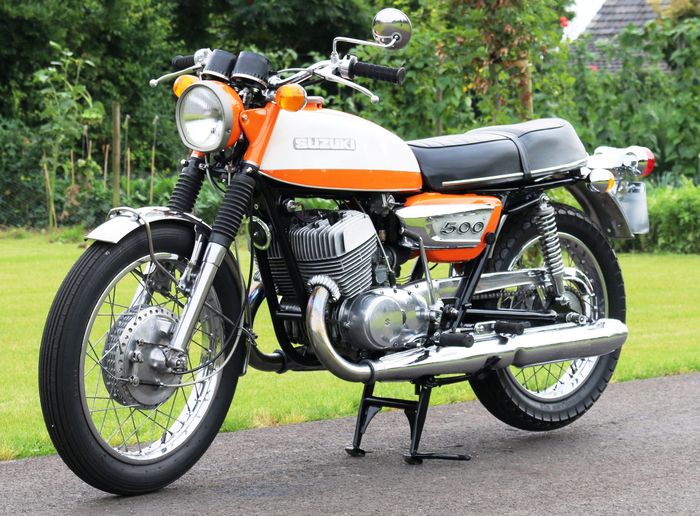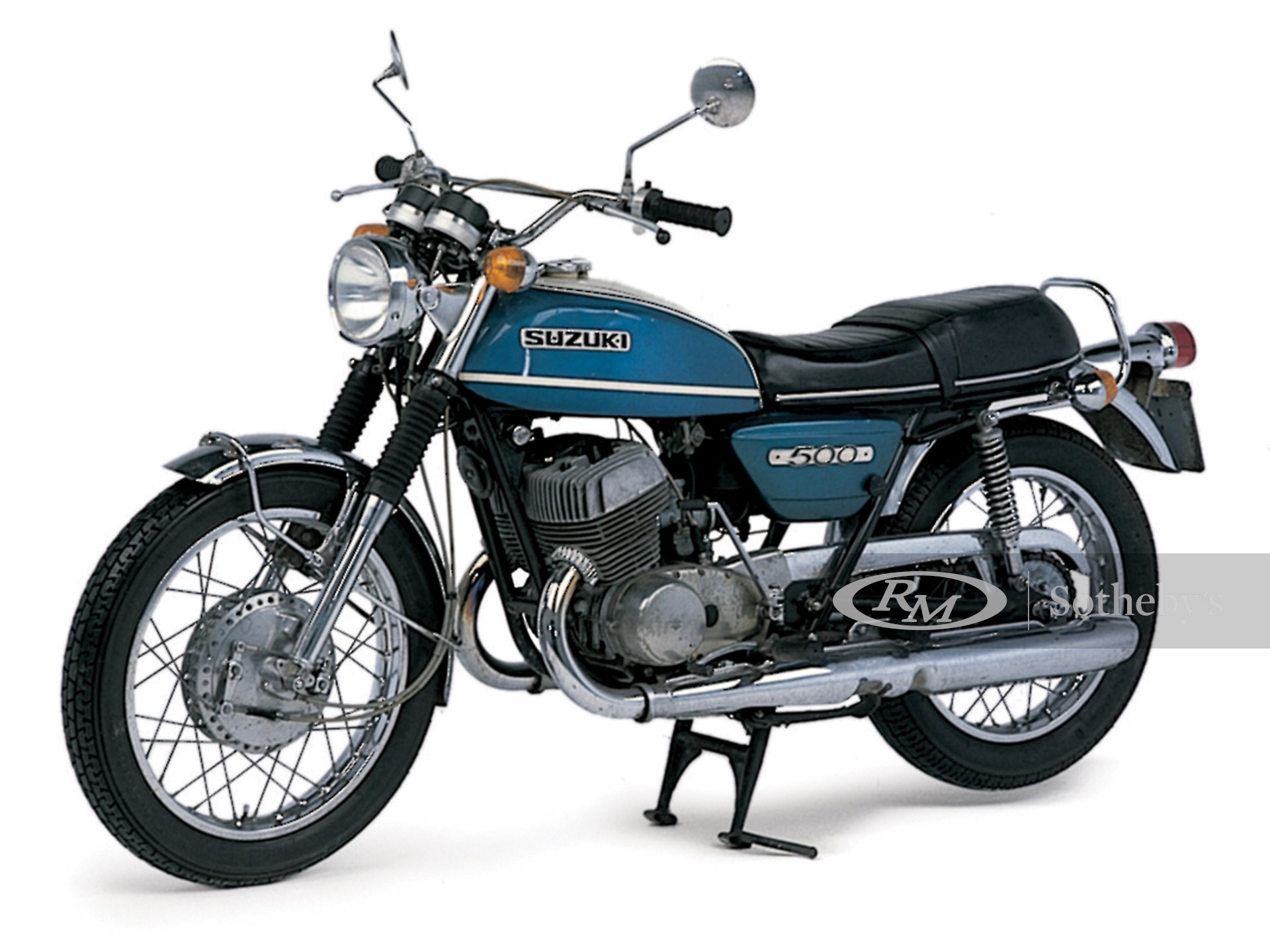The road machines - the T500 and the GT500
THE MIGHTY SUZUKI TITAN
THE BRUTE WITHOUT BULK!
The Suzuki Titan was a shot in the arm for lovers of fast and loud motorcycles who could overcome the blanket dislike of two-strokes that was common at the time. As discussed in the article on the Suzuki Cobra (see Australian Classic Motorcycling Issue No. 20), the predecessor to the Titan, this was one 500cc twin which had solved the un-reliability, peakiness and generally messy nature of two-stroke riding. The Suzuki 500 was a relatively smooth, ultra-reliable, economical, light machine which provided an impressive high speed, good acceleration and stable handling at a very reasonable purchase cost.
The off-set to all of this was noticeable vibration through the pillion pegs at over 60 mph (nothing compared to a certain 650cc British twin, though), a cloud of blue smoke from the ample exhausts when cold, significant piston/ring rattle at low revs (sometimes sounds like a can of nuts and bolts has been dropped in the inlet port) and of course a nauseating 'bop, bop, burble, pop, bop, bop, burble, pop' from the pipes at low speed which could never replace the sound of a Norton Commando or a Triumph Trident on song.
1970 Titan riders were tough Marlboro men, presumably!
Suzuki Titan For Sale
Of course this was all irrelevant to the average young motorcyclist of the time who was being asked to choose between aging (even then) British twins, Honda 450's and Yamaha and Kawasaki 350's. The Titan was a full 500cc, a most popular size at the time, when 650cc was considered big. Many young riders entering the rapidly growing bike market did not have pre-conceptions of what a bike should be. They were looking for fast and flashy bikes and performance was the name of the game. The big two- strokes were delivering the performance and beginning to dominate the Grand Prix, though that was really of little interest here before the age of live television coverage or video.

Helping to sell machines like the Suzuki 500 was their superior performance over comparable machines and their ultra-reliability and low maintenance. Hard as it is to admit now, the British competition was its own worst enemy, as perusal of contemporary journals will reveal. Quality control was at an all time low, model changes were often made for the worst, cost cutting led to dreadful bastardised machines and reliability on the road was truly dismal. Simple things such as constantly breaking cables, vibration, and more serious mysterious seizures, short-lived bearings and burnt valves all helped to persuade the young buyer to go Japanese. No wonder rattly two-strokes became machines of some standing and attracted a loyal following that is still strong today.
A little disclaimer at this point perhaps. British bikes were, and are, capable of giving good service when ridden and maintained in the manner their designers intended. There were also serious faults with the British industry in the 60's and while the performance of British bikes slowly improved it was often at the expense of reliability and smoothness. But British bikes have a charisma and an appeal that is at the heart of the Classic motorcycling movement and that is why enthusiasts collect bikes as varied in performance and value as Vincents, Panthers, James and Bantams. No matter what make it is or how bad it performed at the time an old bike has a nostalgic value to someone that can never have a price put on it. This no doubt will even be the lot of early Japanese machines as the late 60's/early 70's rider grows older and nostalgic for the good old days that they experienced!
- Found this great site with free downloads of owners manuals, parts lists and workshop manuals for stacks of popular bikes. Have a look - donate if you feel guilty for taking something for nothing lol.
- The 'Titan' name was dropped and the designation became, simply, GT500 for both the 1976 and 1977 model years. At the end of the 1977 model year, the 500 was dropped from Suzuki's model line after a production run of ten model years and well over 100,000 examples produced.
The Titan at it's flashiest - the T500J of 1972
Anyway, the last time we were talking about the Suzuki 500 twin we discussed the questionable advertising hyperbole that accompanied the release of the Cobra i.e. 'the bike that couldn't be built' etc. Well by the time the Titan was released in 1970, this was clearly arrant nonsense and the factory was proclaiming the machine's seemingly effortless power instead. The bite of the 'Cobra' was exchanged for the strength of a 'Titan'. Understandable, for by now Kawasaki had released the 500 Kawasaki which had eclipsed nearly every bike for sheer power, acceleration and speed, albeit at the expense of handling and reliability! Thus the Suzuki advertisements of the time highlighted the steroidal, masculine features of the Titan instead.
Is the on-looker tougher than the bike - the long and lean T500J model of 1972
'THE BRUTE WITHOUT BULK', the pamphlet leads, 'this is the giant of the motorcycle clan - yet it looks clean as a whistle with the grace of a gazelle. Does this make the point? Well, demand has caused this to be the first mass-produced 2-stroke, twin-carburetor 500cc model in the world. A cool 6,500rpm puts the full 47hp at your command with a top speed of 192kph. When you want to stop, a dual safety system of oversized brakes and super-grip high speed tires quiets down the brute right now..smoothly. The non-glare, speedometer and tachometer is a vote for safety. Big features and small - such as Suzuki's famous Posi- Force Lubrication and the newly-designed fuel tank luggage rack - all set out in a yummy Candy Colors with red-lined tires make this the fair- haired brute you've been looking for.'
'The fair haired brute you've been looking for'! Somehow I think the Suzuki ad-men got that bit of market research all screwed up. They also had a nice turn of phrase when they described the auto lubrication system..'Posi-Force lubrication is the world's most advanced lubing system..it spews pure oil, never polluted by fuel gas, directly over the ..big end' etc! A touch of class?
A 1972 T500J model with wrong mudguards and tail-lights, but hey who's being picky?
For those who didn't read the article on the Cobra, I'll just recap a bit. The Cobra, being the bike that couldn't be built, was a sensation in 1968. A big two-stroke that ran faultlessly, didn't foul plugs, performed like a 650 four stroke; but was light and cheap to buy. It had strange handling, the thirst of a cane-cutter and by today's standards woeful brakes. It looked kinda dumpy too, in typical 60's Japanese style, with a velour seat, a short wheelbase and a watermelon shaped petrol tank. To many of the buying public though it was a hit, everything worked together fine. The engine and gearbox are well balanced for the road, the engine comes on strong over four thousand revs, (up to a claimed 47 bhp at 6,500), and there is no need to constantly screw open the throttle around town as there is ample low down pulling power. Not what the un-initiated would expect from a two- stroke!



